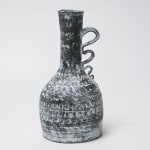Yasuhara Kimei 安原喜明 1906-1980
H23.3 x Dia11.9 cm
Further images
-
(View a larger image of thumbnail 1
)

-
(View a larger image of thumbnail 2
)

-
(View a larger image of thumbnail 3
)

-
(View a larger image of thumbnail 4
)

-
(View a larger image of thumbnail 5
)

-
(View a larger image of thumbnail 6
)

-
(View a larger image of thumbnail 7
)

-
(View a larger image of thumbnail 8
)

-
(View a larger image of thumbnail 9
)

-
(View a larger image of thumbnail 10
)

-
(View a larger image of thumbnail 11
)

-
(View a larger image of thumbnail 12
)

-
(View a larger image of thumbnail 13
)

In his kiln-side notes at night, as published in Meguro Museum of Art's exhibition catalog in 1993, Yasuhara writes:
"Stoneware tells romantic tales of the past that you might not know unless you're familiar with it, and this sense of nostalgia and gentleness is quite captivating.
I dream of revisiting and reassembling these forgotten stoneware pieces with a modern sensibility, believing that something beautiful can be created once again through this process."
This piece conjures up a sense of history with its resemblance to ancient Sue pottery shapes found in archaeological excavations. The vase's fluted, flared lip and angled shoulder invoke Yasuhara's fascination with archaeological pottery, and the inspiration taken from the origins of Japanese pottery during the Sue period, which dates back to the 5th or 6th centuries.
Yasuhara Kimei, also known as Yasuhara Yoshiaki, was born in Tokyo in 1906. He was one of Japan's most avant-garde ceramic artists of his time. Famous for his stoneware "炻器 Sekki" ceramic works such as this flower jar, he conceptualized the "Object Vase", or "vase as an art object", which had an influence that transcended the world ceramics alone.
To create these "Sekki" works, which were formally inspired by archaeological Sue ware forms, Yasuhara used a combination of red Seto and Shigaraki clays, which when mixed with ground feldspar, iron oxide and cobalt, produced a distinctive dark surface. Yasuhara utilized a diversity of tools to create his unique designs including, bamboo spatulas, nails, saws and stamps. The techniques applied to create these vessels and the artistic vocabulary displayed on many of the works shown in this catalogue and exhibition are emblematic of the myriad influences on early twentieth-century Japanese ceramicists, who strived to define themselves as individual artists and ceramics as a path for personal expression. Like his contemporaries, Yasuhara was inspired by the technical virtuosity and unique surface decoration of historical ceramics created in China and Korea, as well as contemporaneous European artists.
Growing up in Tokyo, his father was a sailor on a foreign route. Although he was not physically strong, he loved art from an early age and learned drawing and painting in his teens. In 1924, at his father's urging, he studied pottery making techniques under Miyagawa Kozan II (1842-1916) in Yokohama, and around 1927, he studied under Itaya Hazan (1872 – 1963), learning how to be an individual ceramic artist.












